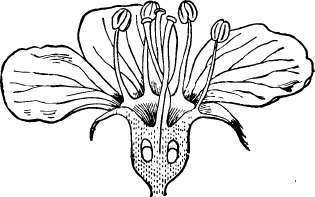33. Inferior and Superior Flowers
Description
This section is from the "American Horticultural Manual Vol1" book, by J. L. Budd. Also available from Amazon American Horticultural Manual, Part One (1902).
33. Inferior and Superior Flowers
In horticulture the flowers of the orchard fruits are divided into two classes, known as inferior and superior.
The cherry and peach are superior in formation, as the fruit forms above the calyx, as shown in Fig. 13. In this case the fruit is developed by growth and alteration of the sides of the ovary and other parts of the pistil in the cherry, often leaving the calyx on the stem of the fruit. In the apple and pear the pistil and calyx grow together and the fruit is practically an enlargement of the whole flower, as shown in the divided flower of the apple at Fig. 14.
In this class of fruits the calyx is shown at the eye of the fruit, while in the cherry it shows at the lower end of the stem. The superior fruits, such as strawberry, raspberry, peach, plum, apricot, cherry, grape, and fig, are more exposed when in flower to frosts, dry air, and other weather changes, and the ovary of the fruit-bud is more liable to be injured in winter, than the inferior class protected by the base of the calyx.
It is also true, as a rule, that the fruits that form above the calyx are not as well fed as those below it, as the connection with the leaves is not as direct. But in this varieties differ. As instances, some varieties of the cherries and plums develop perfect leaflets at the flower-clusters by the time the flowers are opening, while other varieties blossom in advance of the leaves. In the prairie States those that develop leaves and flowers together are more certain to bear regular crops.

Fig. 14.- Divided flower of the apple.
Continue to:


